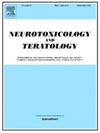丹酚酸A通过gaba能途径增强地西泮的镇静作用:体内、分子对接和药代动力学方法
IF 2.8
3区 医学
Q3 NEUROSCIENCES
引用次数: 0
摘要
丹酚酸A (Salvianolic acid A, SAL A)是一种从丹参中提取的多酚类化合物,具有多种神经保护作用,但其镇静作用尚未得到证实。本研究探讨了SAL A的镇静作用及其在硫贲妥钠(TS)诱导的瑞士白化小鼠睡眠模型中调节地西泮(DZP)影响的潜力。小鼠腹腔注射5、10 mg/kg的SAL A和2 mg/kg的DZP,然后注射20 mg/kg的TS,记录睡眠潜伏期和持续时间。分子对接和计算机分析评估了SAL A与GABAA受体(α1和β2亚基)(PDB ID: 6X3X)的相互作用及其药代动力学性质。结果显示SAL显著(p <;0.05)减少睡眠潜伏期,延长睡眠持续时间,以10 mg/kg效果最强(潜伏期:14.29±3.09 min;持续时间:175.71±18.97分钟;Cohen’s d分别= 4.37和1.60)。与SAL A-10和DZP-2联合治疗可协同延长睡眠时间,观察到的效应值最高(潜伏期d = 5.45;4.36(持续时间)。分子对接研究表明,SAL A与6X3X具有相似的结合亲和力(−8.7 kcal/mol),与DZP相当。SAL A还表现出良好的药动学特性和低毒性。这些发现提示SAL A是一种潜在的新型镇静剂,与DZP具有协同作用。然而,SAL A较差的血脑屏障渗透性和对结构优化的需求突出了未来机制研究、增强给药方法和临床验证的必要性,以确认其治疗睡眠障碍的潜力。本文章由计算机程序翻译,如有差异,请以英文原文为准。

Salvianolic acid A enhances sedative effect of diazepam through the GABAergic pathway: In vivo, molecular docking, and pharmacokinetics approaches
Salvianolic acid A (SAL A), a polyphenolic compound derived from Salvia miltiorrhiza, exhibits several neuroprotective effects, but its sedative potential is unexamined. This study explores the sedative effects of SAL A and its potential to modulate the impacts of diazepam (DZP) in a thiopental sodium (TS)-induced sleep model in Swiss albino mice. Mice received intraperitoneal (i.p.) doses of SAL A (5 and 10 mg/kg) and DZP (2 mg/kg), followed by TS (20 mg/kg), with sleep latency and duration recorded. Molecular docking and in silico analyses evaluated SAL A’s interaction with the GABAA receptor (α1 and β2 subunits) (PDB ID: 6X3X) and its pharmacokinetic properties. Results revealed that SAL A significantly (p < 0.05) reduced sleep latency and prolonged sleep duration dose-dependently, with 10 mg/kg showing the strongest effect (latency: 14.29 ± 3.09 min; duration: 175.71 ± 18.97 min; Cohen's d = 4.37 and 1.60, respectively). Combined therapy with SAL A-10 and DZP-2 synergistically enhanced sleep duration, with the highest effect sizes observed (d = 5.45 for latency; 4.36 for duration). Molecular docking studies revealed that SAL A showed similar binding affinity (−8.7 kcal/mol) with 6X3X, comparable to DZP. SAL A also exhibited favorable pharmacokinetic properties and low toxicity. These findings suggest SAL A as a potential novel sedative agent with synergistic effects alongside DZP. However, SAL A's poor blood-brain barrier permeability and need for structural optimization highlight the necessity for future mechanistic studies, enhanced delivery methods, and clinical validation to confirm its therapeutic potential for sleep disorders.
求助全文
通过发布文献求助,成功后即可免费获取论文全文。
去求助
来源期刊
CiteScore
5.60
自引率
10.30%
发文量
48
审稿时长
58 days
期刊介绍:
Neurotoxicology and Teratology provides a forum for publishing new information regarding the effects of chemical and physical agents on the developing, adult or aging nervous system. In this context, the fields of neurotoxicology and teratology include studies of agent-induced alterations of nervous system function, with a focus on behavioral outcomes and their underlying physiological and neurochemical mechanisms. The Journal publishes original, peer-reviewed Research Reports of experimental, clinical, and epidemiological studies that address the neurotoxicity and/or functional teratology of pesticides, solvents, heavy metals, nanomaterials, organometals, industrial compounds, mixtures, drugs of abuse, pharmaceuticals, animal and plant toxins, atmospheric reaction products, and physical agents such as radiation and noise. These reports include traditional mammalian neurotoxicology experiments, human studies, studies using non-mammalian animal models, and mechanistic studies in vivo or in vitro. Special Issues, Reviews, Commentaries, Meeting Reports, and Symposium Papers provide timely updates on areas that have reached a critical point of synthesis, on aspects of a scientific field undergoing rapid change, or on areas that present special methodological or interpretive problems. Theoretical Articles address concepts and potential mechanisms underlying actions of agents of interest in the nervous system. The Journal also publishes Brief Communications that concisely describe a new method, technique, apparatus, or experimental result.

 求助内容:
求助内容: 应助结果提醒方式:
应助结果提醒方式:


